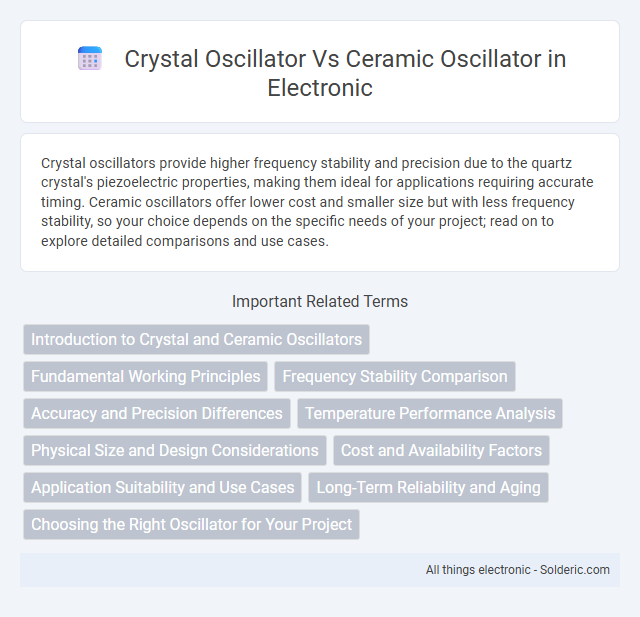Crystal oscillators provide higher frequency stability and precision due to the quartz crystal's piezoelectric properties, making them ideal for applications requiring accurate timing. Ceramic oscillators offer lower cost and smaller size but with less frequency stability, so your choice depends on the specific needs of your project; read on to explore detailed comparisons and use cases.
Comparison Table
| Feature | Crystal Oscillator | Ceramic Oscillator |
|---|---|---|
| Frequency Stability | High (+-10 ppm to +-50 ppm) | Moderate (+-50 ppm to +-100 ppm) |
| Frequency Range | Low to High (up to 200 MHz) | Typically Low to Medium (up to ~30 MHz) |
| Accuracy | Very Accurate | Less Accurate |
| Temperature Sensitivity | Low | Higher |
| Cost | Higher | Lower |
| Size | Medium to Large | Small |
| Typical Applications | Communication devices, precision instruments | Consumer electronics, low-cost timing |
| Power Consumption | Low | Moderate |
| Long-term Stability | Excellent | Fair |
Introduction to Crystal and Ceramic Oscillators
Crystal oscillators utilize quartz crystal to generate precise and stable frequency signals through piezoelectric effect, ensuring high accuracy and low phase noise ideal for communication and timing applications. Ceramic oscillators use ceramic resonators made from lead zirconate titanate, offering lower cost, smaller size, and moderate frequency stability suitable for consumer electronics and low-precision devices. Both oscillators serve as fundamental timing sources in electronic circuits, with crystal oscillators preferred for high-frequency stability and ceramic types favored for cost-effective and compact solutions.
Fundamental Working Principles
Crystal oscillators operate based on the piezoelectric effect of quartz crystal, which generates a precise and stable frequency through mechanical vibrations when an electric field is applied. Ceramic oscillators utilize the piezoelectric properties of ceramic materials, producing oscillations with slightly less frequency stability compared to quartz crystals but with advantages in cost and size. Your choice depends on whether you prioritize frequency accuracy and stability, where crystal oscillators excel, or compactness and affordability, which favors ceramic oscillators.
Frequency Stability Comparison
Crystal oscillators offer significantly higher frequency stability compared to ceramic oscillators due to their precise piezoelectric quartz resonators, maintaining stability often within +-10 ppm across temperature variations. Ceramic oscillators, relying on less stable ceramic materials, exhibit frequency deviations typically ranging from +-50 to +-200 ppm, making them less suitable for applications requiring stringent timing accuracy. Choosing a crystal oscillator ensures your electronic system benefits from minimal frequency drift and improved long-term reliability.
Accuracy and Precision Differences
Crystal oscillators offer superior accuracy and precision due to their stable quartz crystal resonators, maintaining frequency stability within +-10 ppm over a wide temperature range. Ceramic oscillators, using piezoelectric ceramic materials, typically exhibit lower frequency stability, often around +-50 ppm, resulting in less precise timing. The inherent material properties of quartz provide better resistance to environmental variations, making crystal oscillators ideal for applications requiring high-frequency accuracy.
Temperature Performance Analysis
Crystal oscillators exhibit superior temperature stability due to their quartz crystal resonators, maintaining frequency variations within +-10 ppm over a wide temperature range of -40degC to 85degC. Ceramic oscillators, relying on piezoelectric ceramic materials, typically show greater frequency deviations, often experiencing shifts of +-50 ppm or more under similar thermal conditions. This makes crystal oscillators the preferred choice for applications requiring precise timing and minimal frequency drift in varying temperature environments.
Physical Size and Design Considerations
Crystal oscillators typically offer a smaller physical size compared to ceramic oscillators, making them ideal for compact electronic devices where space is limited. Their design incorporates a quartz crystal that provides superior frequency stability and low phase noise, which is critical for precision applications. You should consider ceramic oscillators for simpler designs where cost-effectiveness and resilience to mechanical shock are prioritized over ultra-precise timing.
Cost and Availability Factors
Crystal oscillators generally have higher manufacturing costs due to the precise quartz crystal used, but they offer superior frequency stability and accuracy. Ceramic oscillators are more economical and widely available, benefiting from simpler production processes and lower material costs. Their widespread use in cost-sensitive applications makes ceramic oscillators a popular choice where exact frequency precision is less critical.
Application Suitability and Use Cases
Crystal oscillators provide superior frequency stability and accuracy, making them ideal for precision applications such as communication systems, GPS devices, and high-frequency RF circuits. Ceramic oscillators offer cost-effective solutions with moderate stability, typically used in consumer electronics, low-end timing devices, and industrial controls where exact frequency precision is less critical. The choice between crystal and ceramic oscillators depends on the specific requirements for frequency tolerance, temperature stability, and budget constraints in the intended application.
Long-Term Reliability and Aging
Crystal oscillators exhibit superior long-term reliability and minimal aging effects due to their high-quality quartz crystal resonators, which maintain frequency stability over extended periods. Ceramic oscillators, while cost-effective and compact, tend to exhibit greater frequency drift and aging because of their piezoelectric ceramic materials that are more sensitive to environmental changes. Your choice of oscillator significantly impacts the long-term stability of timing applications, with crystal oscillators preferred for critical systems requiring precise frequency control.
Choosing the Right Oscillator for Your Project
Choosing the right oscillator for your project depends on accuracy, frequency stability, and cost requirements; crystal oscillators offer superior precision and long-term stability, making them ideal for high-frequency and timing-sensitive applications. Ceramic oscillators provide a lower-cost alternative with moderate frequency stability, suitable for general-purpose and less critical timing uses. Evaluate environmental conditions, frequency tolerance, and budget constraints to determine the most suitable oscillator type for optimal performance.
Crystal oscillator vs Ceramic oscillator Infographic

 solderic.com
solderic.com